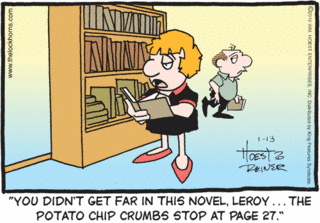I borrowed this book from the library because Springfield’s book fair season is far shorter than St. Louis’s. Well, that’s not the real reason. While I was at the library last week looking for some beading books to browse and review, I saw this book on the hot books shelf, so I got it (along with Night and Day. The end result is that I’ve read a pile of library books this year, which is not helping me move the books from the To-Read shelves to the Read shelves here at Nogglestead.
This book is one of Sandford’s departures from the Davenport series, although Lucas appears as a supporting character and speaks with a voice that ultimately isn’t true to the Davenport character. But that’s not important, since this is a spin-off series. Instead, all the investigation is done by Virgil Flowers.
The Flowers character isn’t as much a leader/chieftan sort of detective as Davenport has become. Although the politics of the other series plays a part, Flowers gets to go and do more low-level shoe leather detecting. So it’s a throwback. Someday, though, Flowers might get promoted up into the bureaucracy to suffer the same fate as Davenport.
Onto this book’s plot: Flowers investigates the murder of a couple of men who are positioned ritually (in a Sandford novel? Say it ain’t so!). He discovers that the plot leads back to the war in Viet-fucking-Nam, man! A team of Vietnamese intelligence agents are killing guys involved in a construction equipment heist. Flowers has to discover this but finds himself embroiled a little too deeply when he falls for the Vietnamese daughter of a purported 60s radical but possible CIA agent. Did I mention the conspiracy goes to the highest levels of the current administration just as the Republican convention comes to Minneapolis?
The moral universe is ambivalent. The Vietnamese killers are seeking vengeance, so they sort of get a pass at the end. I don’t really get the ritualistic slaughter thing. Seriously, that’s warning the others in the circle of Those Who Need Killing According to The Vietnamese Government Officials to put extra security in place. I wonder if it’s added for tabloidic interest. I can think of reasons to put it in, but those reasons don’t come out in the book, and they require some thought on my part. Ultimately, if I were a crack Vietnamese Intelligence team, I would have just tossed the victims off of different bridges without drawing police attention or the remaining victims’ intention. All other explanations require too much predicting that the plot would unfold as it did and that unknown police investigators would react just so to let the plot go on.
Another thing: this book weighs in at almost 400 pages. Do you, gentle reader, remember when Steven King’s huge volumes weighed in at this? When 400 pages was the mark of an Important Work, not just genre fiction? The contemporary page inflation of thrillers will, mark my words, lead to a revised interest in the classics, where a Charles Dickens or Thomas Hardy novel seems light by comparison.
Books mentioned in this review:



